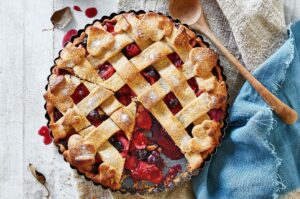
Pastry making requires several essential tools and equipment to ensure that the ingredients are accurately measured and mixed. Measuring cups and spoons are crucial for achieving precision in pastry making. The spoon and sweep method is a popular way to measure dry ingredients, where the ingredient is spooned into the measuring cup and then leveled off with a straight edge utensil. It is important not to use the measuring cup to scoop flour, as this can lead to inaccurate measurements. Mixing bowls are also essential for pastry making, and it is recommended to use bowls that are easy to clean and stable when working with heavy dough.
Spatulas are also important tools for pastry making, as they help to scrape down the sides of the bowl and pick up the dough frequently to prevent it from sticking. Pastry brushes are useful for brushing egg wash or melted butter onto pastry dough. A rolling pin is necessary for rolling out pastry dough to the desired thickness and shape. It is important to avoid rolling dough on rough or uneven surfaces to prevent the dough from sticking.
In summary, having the right tools and equipment is essential for perfecting pastry making skills. Measuring cups and spoons, mixing bowls, spatulas, pastry brushes, and a rolling pin are all essential tools for pastry making. It is important to use these tools correctly to achieve precise measurements and ensure that the dough is mixed and rolled evenly. By using the appropriate tools and techniques, pastry making can become a fun and rewarding experience.
Techniques for preparing pastry dough
Preparing pastry dough is an essential skill for any baker. The first step in creating perfect pastry dough is to master the mixing and kneading techniques. Properly mixed dough is critical to achieving great pastry, and understanding what happens during the mixing and kneading process is essential. Using your hands to mix and knead the dough is the best way to get a feel for its precise hydration level and elasticity. Kneading the dough until it is smooth and elastic is important to develop the gluten and create a strong structure for the pastry. Thus, mastering mixing and kneading techniques is crucial for creating perfect pastry dough.
Resting and chilling the dough is another critical step in creating perfect pastry dough. Resting the dough for at least 30 minutes allows the gluten to relax and the dough to become more pliable. Chilling the dough after it is rolled is also important to prevent shrinkage and maintain the dough’s shape during baking. Placing the dough to be chilled inside a plastic bag and flattening it with a rolling pin can help the dough chill quickly and give you a head start on the rolling process. Thus, taking the time to rest and chill the dough is essential for creating perfect pastry.
Rolling and cutting the dough are the final steps in creating perfect pastry. When rolling out the dough, it’s important to use a long, heavy rolling pin to create an even pastry that doesn’t require too much pressure. Rolling away from you and avoiding downward pressure on the dough is also important to prevent over-rolling and maintain the dough’s texture. For a one-crust pie, tucking the overhang under to create a thicker edge can make crimping easier. With puff pastry, it’s important to remember not to over-roll and to roll away from you to prevent deflating the pastry’s layers. Ina Garten’s clever trick of using a ruler to guide the dough into a rectangle shape can also help prevent overhandling the dough. Thus, mastering the rolling and cutting techniques is crucial to creating perfect pastry.
Baking techniques for perfecting pastry products
One of the most important aspects of baking perfect pastry products is properly preheating the oven and setting the correct baking temperatures. Knowing how long it takes for your oven to preheat can help you determine when your baked goods will be ready. An oven thermometer can also be helpful in ensuring that the oven is at the correct temperature. It is also important to use the upper and lower thirds of the oven and to reverse the baking sheets from upper to lower halfway through the baking process to ensure even baking.
Proper use of baking sheets and pans is another key factor in achieving the perfect pastry. Using a non-stick pan spray or greasing the pan with butter and flour can prevent sticking and ensure easy removal of the baked goods. Investing in high-quality baking sheets made of aluminized steel can also contribute to achieving the perfect crust and texture. Different types of baking sheets and pans can be used for different types of pastry products, so it is important to understand the differences and when to use each variety.
Techniques for achieving the perfect crust and texture of pastry products include keeping everything as cold as possible, using a bit of shortening, and using the tips of your fingers to press the fat into the flour mixture. Other techniques include caramelizing sugar, laminating dough for flaky pastries, working with naturally leavened dough, tempering chocolate, and piping with precision. Learning and mastering these techniques can take time, but with practice and patience, anyone can perfect their pastry skills and create delicious baked goods.
Tips for decorating and presenting pastry products
Decorating pastry products requires creativity and skill. One of the most popular techniques for decorating pastries is using icing and frosting. Spatula icing is a great way to create a smooth and even surface on cakes before adding any decorations. Swirls, rosettes, and other piping techniques can be used to create beautiful and intricate designs on cakes, cupcakes, and cookies. Additionally, piping strings of pearls and dots can add a touch of elegance to any pastry product. It is important to practice these techniques beforehand to ensure that they are executed perfectly on the final product. By mastering these techniques, pastry chefs can create stunning and visually appealing pastry products.
Plating and presentation techniques are just as important as decorating techniques when it comes to pastry products. Creating height on the plate, playing with textures, and using contrasting colors can make a pastry product look more visually appealing. Butchering skills, portion control, and cooking techniques are also important factors to consider when presenting pastry products. Choosing the right plate and amount of food can make the dish feel generous, while still leaving the lip of the plate visible. By mastering these plating and presentation techniques, pastry chefs can elevate their pastry products to the next level.
Proper storage and preservation techniques are essential for maintaining the quality of pastry products. Baking ingredients have a shelf life and can spoil if not stored properly. Frozen dough requires special handling techniques, such as proper storage and defrosting methods, to ensure that its quality is not compromised. By following these storage and preservation techniques, pastry chefs can ensure that their pastry products maintain their freshness and quality for extended periods of time.






